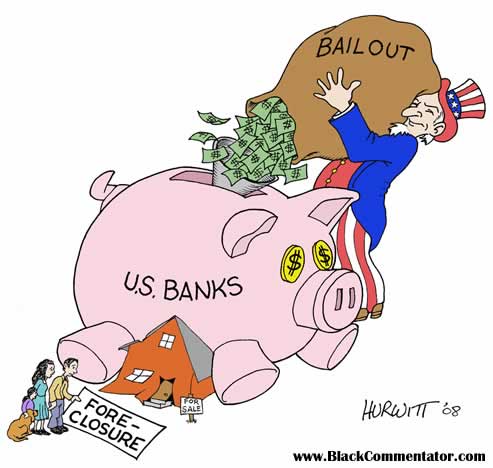Bailout funds to fix the economy come at a higher cost to U.S. taxpayers.
Originally, the Congressional Budget Office had projected that last year’s $700 billion Troubled Asset Relief Program (TARP) would cost taxpayers $189 billion. With the new budget thrown in for 2009 and 2010, this figure has risen to $356 billion. (Reuters)
The Treasury Department has announced plans to use some of the money to help avoid home foreclosures and made new deals with Bank of America and the notorious American International Group (AIG).
On April 3, 2009, the Office of Management and Budget (OMB) published Implementing Guidance for the American Recovery and Reinvestment Act of 2009 (“Recovery Act”). This is the second installment of detailed government-wide guidance for carrying out programs and activities enacted in the Recovery Act. Read April 3 detailed guidance memorandum.







An Easily Understandable Explanation of Derivative Markets
Heidi is the proprietor of a bar in Sydney . She realizes that
virtually all of her customers are unemployed alcoholics and, as such,
can no longer afford to patronize her bar. To solve this problem, she
comes up with a new marketing plan that allows her customers to drink
now, but pay later. She keeps track of the drinks consumed in a ledger
(thereby granting the customers loans).
Word gets around about Heidi’s “drink now, pay later” marketing
strategy and, as a result, increasing numbers of customers flood into
Heidi’s bar. Soon she has the largest sales volume for any bar in
Sydney .
By providing her customers freedom from immediate payment demands,
Heidi gets no resistance when, at regular intervals, she substantially
increases her prices for wine and beer, the most consumed beverages.
Consequently, Heidi’s gross sales volume increases massively.
A young and dynamic Vice President at the local bank recognizes that
these customer debts constitute valuable future assets, and increases
Heidi’s borrowing limit. He sees no reason for any undue concern, since
he has the debts of the unemployed alcoholics as collateral.
At the bank’s corporate headquarters, expert traders transform these
customer loans into DRINKBONDS, ALKIBONDS and PUKEBONDS. These
securities are then bundled and traded on international security
markets. Naive investors don’t really understand that the securities
being sold to them as AAA secured bonds are really the debts of
unemployed alcoholics.
Nevertheless, the bond prices continuously climb, and the securities
soon become the hottest-selling items for some of the nation’s leading
brokerage houses.
One day, even though the bond prices are still climbing, a risk manager
at the original local bank decides that the time has come to demand
payment on the debts incurred by the drinkers at Heidi’s bar. He so
informs Heidi.
Heidi then demands payment from her alcoholic patrons, but being
unemployed alcoholics they cannot pay back their drinking debts. Since
Heidi cannot fulfill her loan obligations, she is forced into
bankruptcy. The bar closes and the eleven employees lose their jobs.
Overnight, DRINKBONDS, ALKIBONDS and PUKEBONDS drop in price by 90%.
The collapsed bond asset value destroys the banks liquidity and
prevents it from issuing new loans, thus freezing credit and economic
activity in the community.
The suppliers of Heidi’s bar had granted her generous payment
extensions and had invested their firms’ pension funds in the various
BOND securities. They find they are now faced with not only having to
write off her bad debt but also with losing over 90% of the presumed
value of the bonds. Her wine supplier claims bankruptcy, closing the
doors on a family business that had endured for three generations, and
her beer supplier is taken over by a competitor, who immediately closes
the local plant and lays off 150 workers.
Fortunately though, the bank, the brokerage houses and their respective
executives are saved and bailed out by a multi-billion dollar,
no-strings attached cash infusion from their cronies in Government. The
funds required for this bailout are obtained by new taxes levied on
employed, middle-class, non-drinkers who have never been in Heidi’s
bar.
Now you understand!!!
unknown author